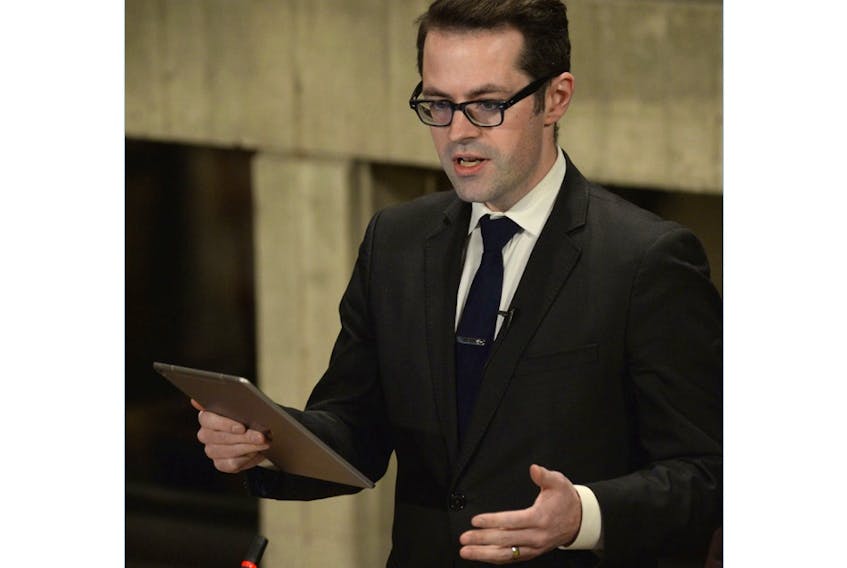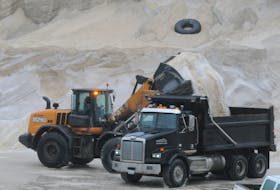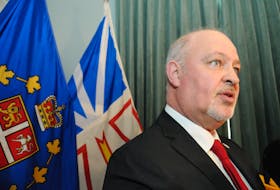St. John’s city council unanimously passed the 2019 budget, which will see mill rates and the water tax rise.
For residential owners, the mill rate is up .4 over last year to 7.7.
Commercial property tax will be based on a mill rate of 26.1, up 1.4 from 2018.
The water tax will also increase by $25, to $605.
While mill rates are increasing, that doesn’t necessarily mean property taxes will increase for all residents.
“Property tax is a very individual thing,” said Coun. Dave Lane, because the amount of tax paid is tied directly to a property’s assessed value.
Lane said 80 per cent of residential property owners will see their taxes increase by less than $10 per month, and one-third of residential property owners will see either no increase to property taxes or a drop in their taxes in 2019.
Residents can calculate their property tax for 2019 by multiplying their property’s assessed value by the mill rate (.0077 for residential and .0261 for commercial) and then add the $605 water tax.
Heading into budget talks, the city faced an $8.8-million shortfall with decreased property values — down $400 million, to $15.5 billion.
“This fact, combined with other unavoidable cost increases, including rising electricity rates and debt servicing charges, result in the need to increase mill rates,” said Lane.
The city projects its electricity costs to rise by $696,000 in the coming year.
The biggest cost to the city is maintaining its infrastructure, work that is funded through cost-shared capital projects. There is a projected increase of $3.3 million in debt-servicing payments to cover the city’s share of those projects — bringing that cost up to $37.7 million in 2019.
Altogether, city expenditures are up 2.4 per cent in 2019 to $304,677,022.
At the Monday evening meeting, longtime council members Coun. Wally Collins and Mayor Danny Breen boasted the budget process was the best they’ve seen in their decade or more serving on council.
“We as a council don’t take raising the mill rate lightly,” said Coun. Jamie Korab.
He and other councillors said tough decisions had to be made, but the engagement process indicated residents did not want to lose services in order to balance the budget.
“We need a city where people want to work and live. This includes (having) things like recreation,” said Korab.
One service many residents seem to take issue with during wintertime is sidewalk snow-clearing, which the city also addresses in the budget.
The city plans to spend an additional $150,000 to improve snowclearing operations, with a particular focus on clearing sidewalks.
Board of Trade reaction
While councillors congratulated one another on a job well done, outside council chambers St. John’s Board of Trade chair Andrea Stack called the budget “very disappointing.”
She said the board has been advocating for the city to decrease expenditures, but her main objection was the commercial mill rate.
Stack said the difference in mill rates for commercial versus residential owners is consistent to previous years, but value assessments of commercial properties increased this year, while residential properties largely saw decreased values.
“That increase in taxation is all falling on the hands of business,” she said.
Stack said there was one positive from the budget — the waiving of development fees for certain core areas of the city.
The city is waiving those fees in an effort to decrease the amount of urban sprawl.
Still, Stack said, the board has been advocating for all development fees to be dropped.
Costs and savings
Payroll costs will also go up – by $3 million – next year.
While the city announced a management wage freeze, some employees will receive increases as part of their contracts which were previously negotiated, such as Metrobus and the St. John’s Regional Fire Department.
The city also budgeted for staff at the new Kenmount Terrace Community Centre, and created a new climate change co-ordinator position, which will have a salary of $125,000.
City councillors will not see an increase to their paycheques. The budget indicates an increase of $17,808 for council, but that’s because previous budgets had not allocated enough for travel costs — this amount reflects actual costs council is expected to spend on travel.
Lane said the city’s three-year plan sees costs continuing to rise over the next two years, and council will ensure tax increases are minimized, but services are maintained.
For 2019, though, the city found savings in a number of areas.
A new snowclearing contract will save $285,000.
The city will also see a saving of $150,000 by switching the city’s phone plans from Bell to Telus.
Getting rid of management staff car allowances resulted in $295,000 in savings.
There was also $1.8 million in savings through the Torbay Road North Capital Reserve Fund.
Breen said in all the years he’s served on council, he’s noticed a difference with this budget process in that the city is really focused on cost-effectiveness.
He called it “the development of a culture of efficiency” at city hall.
Twitter: @juanitamercer_
Earlier story:
Mill rate to rise for St. John’s residents
St. John’s residents will see an increase in their mill rate and water taxes in 2019, but city council says it anticipates no reduction in services to residents.
Budget details were provided to reporters Monday afternoon ahead of city council’s public meeting, at which a vote was to take place. Last year, only one council member opposed approving the city’s annual budget.
Heading into the budget, the city faced an $8.8-million shortfall.
Coun. Dave Lane, lead for finance, said in order to present a balanced budget for 2019, the mill rate for residential property owners will increase .4 from the 2018 rate to 7.7. Commercial property tax will be based on a mill rate of 26.1, up 1.4 from 2018.
Water taxes will increase $25, to $605, in 2019.
Because the total value of properties in the city decreased from $15.9 billion in 2018 to $15.5 billion in 2019, the city would have a shortfall in revenue if it maintained the existing mill rate, said Lane.
He also noted that expenditures for 2019 are budgeted at $304,677,022, up 2.4 per cent from 2018, which he called a “marginal increase relative to the size of the city’s budget, but an increase nonetheless.”
“This fact, combined with other unavoidable cost increases, including rising electricity rates and debt servicing charges, result in the need to increase mill rates.”
The city projects its electricity costs to rise by $696,000 in the coming year.
However, Lane said the budget “anticipates no reduction in services to the residents.”
The biggest cost to the city is maintaining its infrastructure – work that is funded through cost-shared capital projects. There is a projected increase of $3.3 million in debt servicing payments to cover the city’s share of those projects – bringing that cost up to $37.7 million in 2019, where it was $34.3 million in 2018.
Payroll costs are also increasing by $3 million next year.
Lane said the city is trying to keep staffing costs down by minimizing new hires, but there was an increase of what is equivalent to 7.94 full-time positions – many of whom are staff hired for the new Kenmount Terrace Community Centre and information technology staff.
While the city announced a management wage freeze, some employees will receive increases as part of their contracts, which were previously negotiated, such as employees at Metrobus and the St. John’s Regional Fire Department.
The current debt outstanding for the city is $445 million.
Property taxes
While mill rates are increasing, that doesn’t necessarily mean property taxes will increase for all residents.
“Property tax is a very individual thing,” said Lane, because the amount of tax paid is tied directly to a property’s assessed value.
Lane said 80 per cent of residential property owners will see their taxes increase by less than $10 per month, and one-third of residential property owners will see either no increase to property taxes or even a drop in their taxes in 2019.
To calculate your property tax for 2019, multiply your property’s assessed values by the mill rate (.0077 for residential and .0261 for commercial) and add the $605 water tax.
“We acknowledge that, for some, any increase in property tax will be a burden and we pledge to work with you to the best of our ability to ease that burden,” said Lane.
The appeal process for property owners is still open for any property owner who has questions or concerns about their assessments. The discount for qualified seniors will also continue. Lane said the city pledges to keep costs down for programs and services. For example, Metrobus fares will remain the same in 2019. However, recreation fees were already increased in October.
Taxation accounts for 67.9 per cent of the city’s revenue in 2019.
Lane said the city’s three-year plan sees costs continuing to rise over the next two years, and council will work to ensure tax increases are minimized but services are maintained.
Sustainability a focus
The city announced plans to develop a new sustainability plan as part of the 2019 budget.
Further details on that plan will be announced during the Monday evening council meeting. However the budget indicates the city created a new position for a climate change co-ordinator, who will earn $125,000.
Savings found
The city saved money with a new snowclearing contract — a total of $285,000 saved, as well as a saving of $150,000 by switching the city’s phone plans from Bell to Telus. Getting rid of management staff car allowances saved $295,000.
The city also found $1.8 million in savings through the Torbay Road North Capital Reserve Fund.
Other highlights
The city plans to spend an additional $150,000 to improve snowclearing operations, with a particular focus on clearing sidewalks.
The city plans to change its seasonal tourist information centre on Water Street into a year-round welcome centre to serve the business community, new Canadians and tourists.
To encourage development in key areas that are near main roads, serviced by public transit and near existing commercial services and schools, the city will waive development fees for any developer who will redevelop those areas — an effort Lane said comes as the city begins “to measure the price of sprawl.”
As previously announced, the city will see an increase in cost to operate Mile One and the Convention Centre in 2019 — up $733,200 to $3,403,200 from the $2,670,000 cost in 2018.
Related Story:
St. John’s council increases recreation fees









